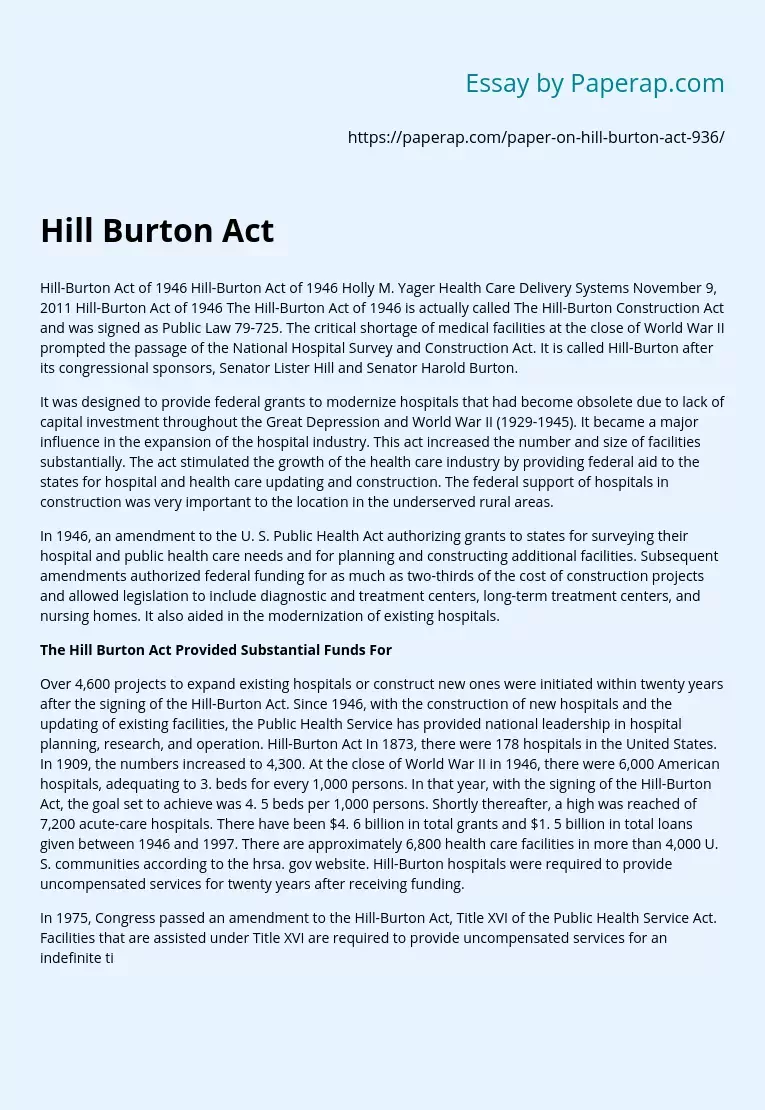Hill Burton Act
Hill-Burton Act of 1946 Hill-Burton Act of 1946 Holly M. Yager Health Care Delivery Systems November 9, 2011 Hill-Burton Act of 1946 The Hill-Burton Act of 1946 is actually called The Hill-Burton Construction Act and was signed as Public Law 79-725. The critical shortage of medical facilities at the close of World War II prompted the passage of the National Hospital Survey and Construction Act. It is called Hill-Burton after its congressional sponsors, Senator Lister Hill and Senator Harold Burton.
It was designed to provide federal grants to modernize hospitals that had become obsolete due to lack of capital investment throughout the Great Depression and World War II (1929-1945).
It became a major influence in the expansion of the hospital industry. This act increased the number and size of facilities substantially. The act stimulated the growth of the health care industry by providing federal aid to the states for hospital and health care updating and construction. The federal support of hospitals in construction was very important to the location in the underserved rural areas.
In 1946, an amendment to the U. S. Public Health Act authorizing grants to states for surveying their hospital and public health care needs and for planning and constructing additional facilities. Subsequent amendments authorized federal funding for as much as two-thirds of the cost of construction projects and allowed legislation to include diagnostic and treatment centers, long-term treatment centers, and nursing homes. It also aided in the modernization of existing hospitals.
The Hill Burton Act Provided Substantial Funds For
Over 4,600 projects to expand existing hospitals or construct new ones were initiated within twenty years after the signing of the Hill-Burton Act.
Since 1946, with the construction of new hospitals and the updating of existing facilities, the Public Health Service has provided national leadership in hospital planning, research, and operation. Hill-Burton Act In 1873, there were 178 hospitals in the United States. In 1909, the numbers increased to 4,300. At the close of World War II in 1946, there were 6,000 American hospitals, adequating to 3. beds for every 1,000 persons. In that year, with the signing of the Hill-Burton Act, the goal set to achieve was 4. 5 beds per 1,000 persons. Shortly thereafter, a high was reached of 7,200 acute-care hospitals. There have been $4. 6 billion in total grants and $1. 5 billion in total loans given between 1946 and 1997. There are approximately 6,800 health care facilities in more than 4,000 U. S. communities according to the hrsa. gov website. Hill-Burton hospitals were required to provide uncompensated services for twenty years after receiving funding.
In 1975, Congress passed an amendment to the Hill-Burton Act, Title XVI of the Public Health Service Act. Facilities that are assisted under Title XVI are required to provide uncompensated services for an indefinite time. Title XVI also transferred the enforcement responsibilities from the states to the federal government and required more stringent investigation, monitoring and compliance standards. In 1979, regulations established compliance levels, eligibility, record maintenance, and reporting requirements.
Hill Burton Act. (2019, Dec 05). Retrieved from https://paperap.com/paper-on-hill-burton-act-936/

